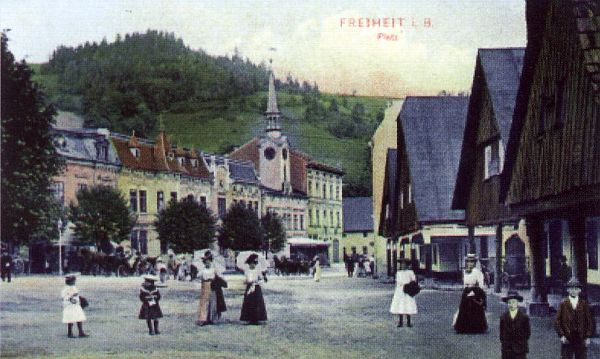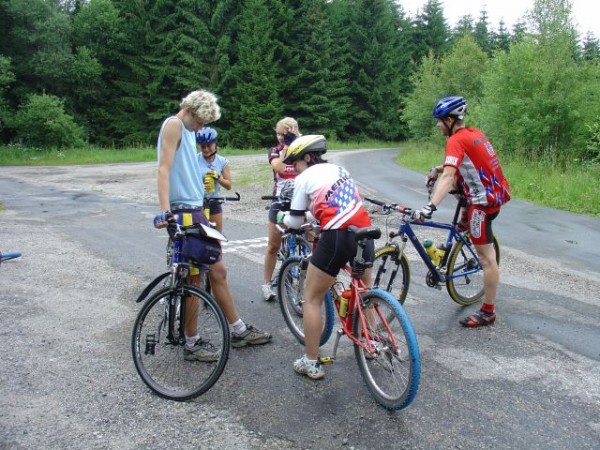The first settlement probably did not arise until 1009, when miners here began to extract silver and gold from the slopes around Svoboda and Rijora. It is safe to say that in the 12th century, the settlement existed under the protection of the lords from Silvarov. Some privileges were given to this small town by Emperor Rudolf II in 1546 when the owners of the mining estate gave tithes from the imperial forests. The state archive contains privileges and seals dating back to 1634. According to documents from 1577, part of the mines in Svoboda and today’s Bistrica belonged to lords from Silvarov. On October 18, 1580, Emperor Rudolf II turned Svoboda into a forge city, at the same time freeing the shareholders from paying tithes. The city of Svoboda had one mine in Bistrica and farm No. 5, including fields, for which a quarterly payment of 1 gold and 33 kreutsars was paid. The proceeds from the mining were verified on March 4, 1673, by the Zemstvo inspector of Holtburg, and it was established that after melting down 21 ducats were obtained in a purity of 23 carats and 11 grains. In 1681 the old shaft was re-lined and the new entrance was closed. On July 17, 1764, the mine was checked, measured, and mapped by order of Prince Schwarzenberg.
However, the late 17th and early 18th centuries were marked by the Great Depression. It is likely that the municipality maintained the mines only to avoid losing the privileges of a mining town. In 1772, mining was completely stopped; in 1781, Prince Schwarzenberg closed the mine. Thus, gold mining in Rychory ended, which never resumed.
In 1650, Svoboda had a mill complex with two wheels, a salt shop, 6 butchers, a bakery, a shoemaker, leather workshops, an infirmary in Janské Lázne (for which 3 thalers were paid annually), as well as other artisans, in total there were 500 people living in the city Human. A transit fee was charged for crossing the bridge over the Upa River. Since 1580, fairs were held here twice a year (the first in honor of St. Lawrence and the Advent fair), since April 20, 1827, fairs were allowed 4 times a year. From 28 April 1653, week-long fairs were also held on Wednesdays and Saturdays. These fairs were canceled in 1810 due to unprofitability.
In 1587 the border was drawn, and this commission was placed with the rich Georg Hanke in Svoboda. They dined at nine tables and spent 124 thalers in fifteen days. Unfortunately, in 1599 the town hall burned down and most of the documents were destroyed.
In 1584, the city already had a church of St. Adalbert, which was under the jurisdiction of Young Beeches. In 1777 it was demolished and a new one was built by Prince Joseph Adam of Schwarzenberg and dedicated to St. John of Nepomuk, the current church tower dates from 1836. In 1856 the temple was consecrated as a parish church. There was a cemetery around the temple, which was closed in 1888, and a new one was founded. The first school appeared around 1747, and the first teacher was Augustin Rube. In 1899, a new school appeared in the city. The first hospital building was created in 1683 and founded by Prince Schwarzenberg. On the square, there is a monument to three saints (author unknown). House No. 107 belonged to the Etrich family, who had a bakery, and one of their descendants invented (made) the Holub (Dove) airplane, which later became a model of Heinkel airplanes. There was a sign on this house that Emperor Joseph II spent the night here on September 12-13, 1779. In 1879, a new tournament hall was opened (nowadays a rather abandoned building on the road to Pec). The city also had gallows, the site of the present Muchomůrka. There must have once been gallows in this place.
Also worth mentioning is the iron bridge over the Úpa River, which was built in 1894 and cost 12,000 gold. A water supply system with excellent water from Rihor was installed with the bridge, and three hydrants were installed, providing a pressure of 7.5 atmospheres. In 1901, the Etrich brothers donated house No. 74 (now Czech Savings) with four forest plots to the city, on the condition that 4 places for the poor would be created.
There were also two paper mills here, the first in the direction of Pez – the former Piette factory. The prosperity of Prosper Piette de Rivage (1846 – 1928) from Luxembourg is linked to a family tradition of paper production from the mid-15th century. Prosper Piette received awards at world exhibitions, and his tobacco paper was without competition. Crepe paper and carbon paper were also produced here. He was a great entrepreneur very open to communication with people and a lover of the Giant Mountains. He built a school. It was opened and began operations on September 15, 1880, as the private school of Prosper Piette. In 1882, the school received permission to become a general education institution. On September 15, the fourth grade was opened, and in 1885 it became a fifth grade and began to report to the land department.
A little higher up was the Eichmann paper mill, where they produced bank paper, photographic paper, photosensitive paper, punch card paper, and copy paper. Between the Piette and Eichmann factories, there is a monument to the flood that occurred on July 29-30, 1897. There was a house on this site that was destroyed during the flood. 17 people became victims. After this disaster, the river bed was deepened to its current state. By the end of 1901, 1,682 people lived in the town.


